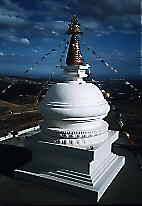The Three Vehicles
Buddhism grew slowly until the third emperor of India, Ashoka (c. 273-237 B.C.E.), who ruled all but the southernmost part of the Indian subcontinent, became a convert. According to tradition, Ashoka was horrified at the human toll taken by his conquests in pursuit of a unified Indian Empire, and he embraced the Buddha’s teachings of nonviolence. Ashoka’s edicts in support of the Buddhist precepts against harming humans and animals and in favor of religious tolerance were engraved on large rocks and stone pillars for all the people to read. Under Ashoka, vegetarianism became state policy and Buddhism spread across most of India.

Over the next 400 years, Buddhism gradually divided into a number of schools and sub-schools. The pejorative overall term Hinayana (“Lesser Vehicle”) was later applied to these early schools by members of the second major branch, who called their school Mahayana (“Great Vehicle”). The only surviving Hinayana school is the Theravada (“Teachings of the Elders”), which spread south and east from India into what is now Sri Lanka, Southeast Asia, and Bangladesh.
The Mahayana began developing around the 1st century B.C.E., mainly in Northwestern and Southern India, where Buddhism came into contact with foreign cultures. Certain teachers, believing that the religion had grown stale and had come to rely too much on the repetition of the sutras, set out to create a new body of work that would make the teachings more relevant and vibrant. These new teachings were presented as having been given by the Buddha but concealed for hundreds of years until they were needed. Some Buddhists reject the notion of any decline in the efficacy of existing teachings or practices, insisting that the Buddha had taught on several different levels, fully intending the more advanced levels to be presented only after the initial groundwork had been laid. According to this interpretation, the faithful first had to purify themselves by following the moral and ethical precepts of the Buddha before they would be ready to receive the more profound teachings of the Mahayana, and later of the Vajrayana. Mahayana traveled north in the 1st century to the Himalayan region, Central Asia, and China, later to Korea and Japan, and in the 7th century to Tibet.
Both Hinayana and Mahayana accept the basic tenets of Buddhism, but Hinayana stressed the liberation of the individual from the cycle of existence. The Hinayana ideal is the arhat, or fully liberated being who experiences nirvana for himself. But enlightenment was limited to male monks under this system; women had to be first reborn as men. Mahayana developed the ideal of everyone becoming a bodhisattva — a fully enlightened being who, rather than experiencing complete nirvana, returns to help bring all sentient beings to enlightenment. This belief is predicated on limitless lifetimes to develop limitless abilities with which to help others achieve enlightenment. A bodhisattva (“enlightenment hero”) is a being who, out of compassion, has made a vow to reach enlightenment for the sake of others, and who by definition is on the path to buddhahood. Bodhisattvas exist at various levels of development over many lifetimes; in the Mahayana tradition there are earthly and transcendent bodhisattvas. The former are still ordinary beings, male or female, who are developing their skills at helping others; the latter, who could also be called celestial or angelic bodhisattvas, are possessed of perfect wisdom and are no longer subject to samsara. Transcendent bodhisattvas can also be female, and few celestial beings are more highly revered by Tibetan Buddhists than Tara (“Savior”), the embodiment of the feminine aspect of compassion.
The understanding of nirvana itself in these two schools also differs substantially. For Theravadins, nirvana is the cut-and-dried extinction of craving, a one-shot deal that follows complete liberation from the bonds of craving. Mahayanists, on the other hand, believe that by the bodhisattva’s very postponement of the bliss of nirvana, he or she has realized true nirvana — that is, a condition of total detachment from any selfish craving, including the craving for eternal bliss. They refuse to make any ultimate separation of nirvana from the world of sense experience, as indicated by the phrase: “nirvana is samsara and samsara is nirvana.” This leads to many questions about the Buddha’s relationship to nirvana, put succinctly by the 2nd century patriarch Nagarjuna: “What is the Buddha after his Nirvana? Does he exist or not exist, or both, or neither? We never will conceive it!”


